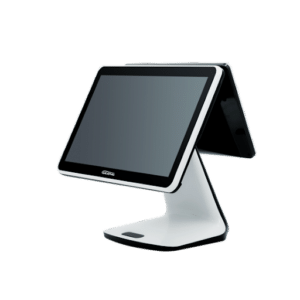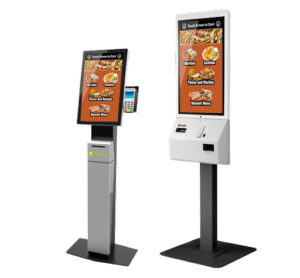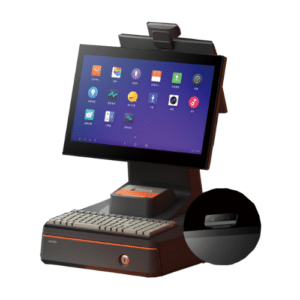What is a POS Terminal?
A POS terminal (point of sale terminal, or a till) is the main component of the hardware of a POS system. This terminal can be a computer, tablet, or smartphone.
It serves as the central unit of a POS system where all sales transactions are processed.
Other devices attached to the POS terminal
There are other hardware devices attached to the POS terminal:
- PDQ machines (which process card payments)
- Barcode scanners (which read product information)
- Receipt printers (which provide physical transaction records)
- Cash drawers (which store cash)
These devices are connected to the POS terminal for a functional POS system. This hardware setup works with the POS software to make everything from billing to inventory management more efficient.
Compare POS System Quotes Today
5 Types of POS Terminal
POS terminals come in various types to match the needs of different businesses. We have listed 5 types of POS terminals below:
1. Traditional POS terminal

Traditional POS terminals are the most common type of POS terminal. These allow businesses to manage sales on the spot. These terminals consist of a computer, desktop, or laptop with other hardware devices connected to it.
Best for:
- Grocery stores
- Electronics stores
- Spas
- Salons
- Restaurants
2. Mobile POS terminal

Mobile POS terminals are portable devices like tablets or smartphones that run POS software. They connect to hardware devices like card readers, barcode scanners, and portable printers via physical cable, Bluetooth, or Wi-Fi.
Best for:
- Street vendors
- Mobile hairdressers
- Market stalls
- Food trucks
- Ice cream shops
- Juice bars
3. Touchscreen POS terminal

These terminals have a touchscreen, which makes them user-friendly and easy to use. Their functioning is similar to that of a tablet or Android, and staff can train to use them in no time.
Best for:
- Fast food restaurants
- Casual restaurants
- Cafes
4. Self-Service POS terminal

Self-service POS terminals function similarly to a touch screen POS terminal. The only difference is that customers can place orders and pay without interacting with staff. This type of terminal helps reduce wait times
Best for:
- Quick-service restaurants with minimal staff
- Bakeries
- Cafes
- Fast food restaurants
- Cinemas
- Self-checkout sections in supermarkets
5. Cloud-Based POS terminal

A cloud-based POS terminal consists of a computer or desktop like a traditional POS terminal. The difference is that it relies on the internet connection for processing transactions over remote servers. All the information, such as sales records, employee information, and inventory records, is stored on a cloud-based POS terminal.
Best for:
- Small to medium-sized businesses
- E-commerce businesses that have brick-and-mortar stores
- Seasonal businesses like stalls
- Holiday shops
- Mobile businesses
- Businesses with multiple locations
Learn in detail about the types of POS systems.
How Does a POS Terminal Work?
Take a look at the following breakdown of how a POS terminal works.
1. Product selection/scanning
Customers select a product that is scanned by a barcode scanner connected to the terminal POS. This is where the transaction process starts. The automatic scanning of the product replaces the manual entry of prices, reducing errors and saving time.
2. Price calculation
Automatically, the POS terminal calculates the total price, factoring in taxes and discounts. This precision ensures accurate billing every time and reduces the chance of manual error.
3. Payment options
POS terminals can accept different types of payment methods, including cash, cards, and mobile wallets. It integrates with PDQ machines or card readers to process transactions. A cash drawer stores the cash if the customer wants to pay with cash.
4. Transaction completion
Once the payment is processed, a receipt is generated by the POS terminal and then printed by the printer. This quick and efficient process allows for faster checkouts, enhancing operational efficiency.
5. Data recording
Each transaction processed by the POS terminal feeds into a database. This information is used to generate reports on sales trends, inventory status, customer interests, and more, providing insights that drive informed business decisions.
Benefits of POS Terminal
Using a POS terminal brings several advantages to all types of businesses. Here are some of the key benefits:
1. Increased business efficiency
POS terminals streamline the checkout process, making transactions quicker and more precise compared to traditional cash registers. This efficiency not only minimises customer wait times but also enhances overall customer satisfaction.
2. In-depth reports and insights
POS terminals generate reports on sales, inventory levels, customer preferences, and employee performance. These insights help business owners to make informed decisions regarding their business and optimise their inventory and staffing.
3. Reduced human error
By automating the entry of transactions, POS terminals reduce manual data entry and automatically minimise errors. This also leads to increased employee efficiency so they can focus on advanced tasks in managing the business.
4. Enhanced customer experience
POS terminals accept a variety of payment methods, including credit/debit cards, mobile payments, and contactless payments. In this way, businesses can accommodate customer preferences and enhance the checkout experience.
Tips for Choosing the Best Type of POS Terminal for Your Business
We have listed some tips so you can choose the right type of POS terminal for your business.
- Identify your business needs, and budget you can set aside for a POS terminal.
- Choose a type of POS that fits well in your space.
- Look for essential software features like inventory management and sales reporting.
- Make sure the POS terminal supports diverse payment methods, including credit, debit, and contactless options.
- Compare quotes with ComparedBusiness and choose the best option that suits your budget and needs.
Get Best POS Terminals with ComparedBusiness
We at ComparedBusiness are experts in saving your time and money. Just submit your requirements in less than 2-mins and ComparedBusiness will get back to you with quotes from a list of the top POS terminal providers. You can pick and choose the best option for your business.
FAQs
Find the best affordable options from top vendors in the UK by comparing quotes with ComparedBusiness. Just submit your requirements in less than 2 minutes and we will get right back to you.
Yes, POS terminals have an upfront buying fee but they also have other costs like software updates, maintenance fees, and monthly subscriptions. It’s important to review these costs to understand the total expense.
For restaurants, consider POS terminals that offer features like table management, order tracking, menu customisation, and the ability to handle split bills.




